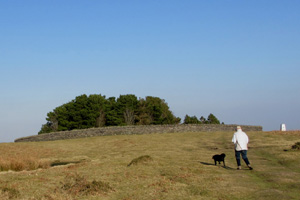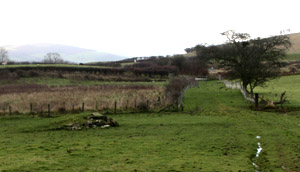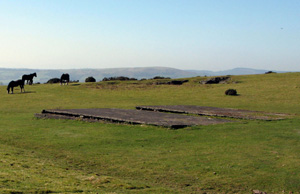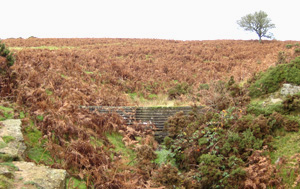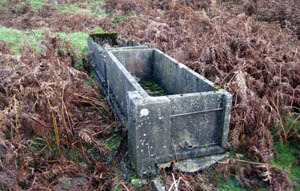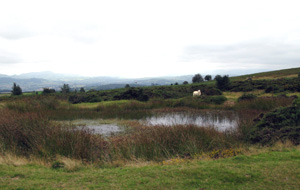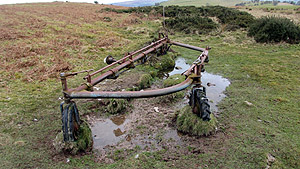| The
Begwyns - Contemporary Archaeology
An overall look at this large area of common land and its place in contemporary archaeology |
 Heading East across the Begwyns with the Roundabout at the top of the picture - B Bowker - 20.04.2014 |
| Introduction The
Begwyns is a large upland area and encompasses a wild and rolling
landscape of common land situated north of Ffynnon-Gynydd and south
of Painscastle. It rises to 415 m at the Begwyns Round Barrow (
contained in the summit Roundabout ) and falls away to a low point
of some 270 m to the NW. The whole area of 1292.98 acres had been
owned for a long period by the Maesllwch Estate before being gifted
to the National Trust by Major G. W. F. De Winton on the 7th July
1992. Since this time the National Trust have been overseeing and
surveying the area on a continuing basis. The Roundabout The original Roundabout was built by the de Winton
family in 1887 to protect the numerous trees which had been planted
to commemorate Queen Victoria's Diamond jubilee. These gradually
disappeared over time along with the wall which fell into total
disrepair by the mid 20c. The Triangulation Pillar The triangulation point close by was adopted in January 1997 by the Beagley family of Cornhill and has been maintained by them admirably since that time. Wartime Activity Some temporary but important events occurred
during World War Two when the War Agricultural Executive Committees
implemented farming changes for a second time. The effect of the
"War Ags" was to increase the productive land in the
UK by over 1.5 million acres between 1939 and the early 1940's
and this included large areas of the commons of Ffynnon-Gynydd
and the Begwyns. Approaching from the west the first of these can be found at GR 139 435 and is the loading ramp mentioned above. The second can be found at GR 143 435. These are the two concrete bases; all that is left of the nissen style huts. The third is the small dam and related water troughs which were constructed for the benefit of the cattle and can be found in the area of GR 149 436. The water was piped from the dam to the troughs to provide a reliable and safe supply. The fourth was a post-war event and is known
locally as 'The Bomb Hole' . During the war ammunition was safely
stored in a variety of depots ( A large one was created at Gwernyfed
) and these became redundant with the advent of peace. After a
few minor and trial explosions it was decided to dispense with
the remaining ammunition in one fell swoop and the Begwyns was
the favoured and chosen site. In due course the ammunition was
sited at a safe distance from the road at GR 178 443 and the demolition
team at a even safer distance in the ditch to the southwest. The
bomb-blast was successful but ruptured the bed-rock below, allowing
a spring-line to create a small lake which has remained since
that time The Bamford Hay Rake This unusual relic was discovered in a little visited
area on the Begwyns. It was identified by Paul Greenow as a Bamford
Hay Rake and was probably abandoned in the early 1950's.
B Bowker Sources "Wales", A
Physical, Historical and Regional Geography. Edited by E.
G. Bowen, M. A. F.S.A. Photos - B Bowker
|
|
